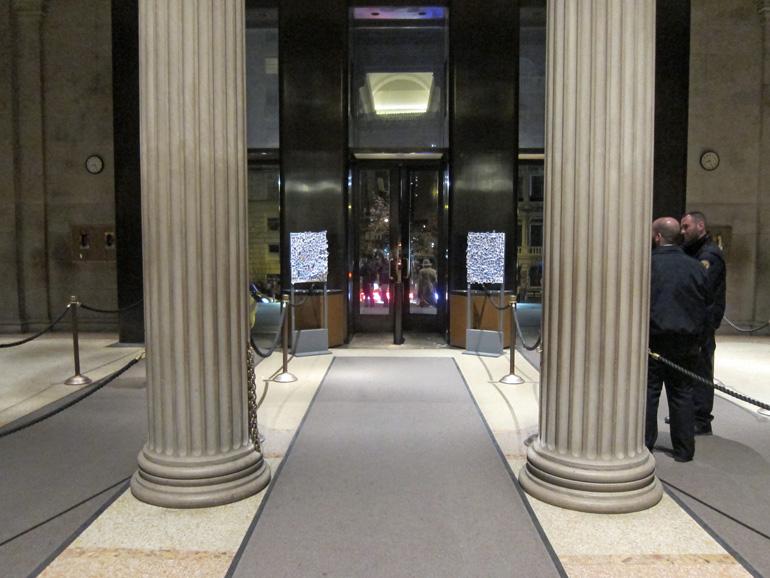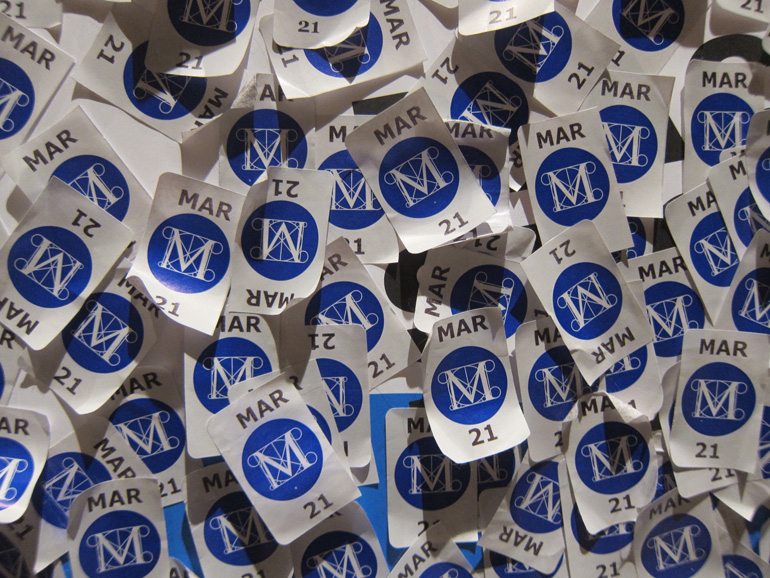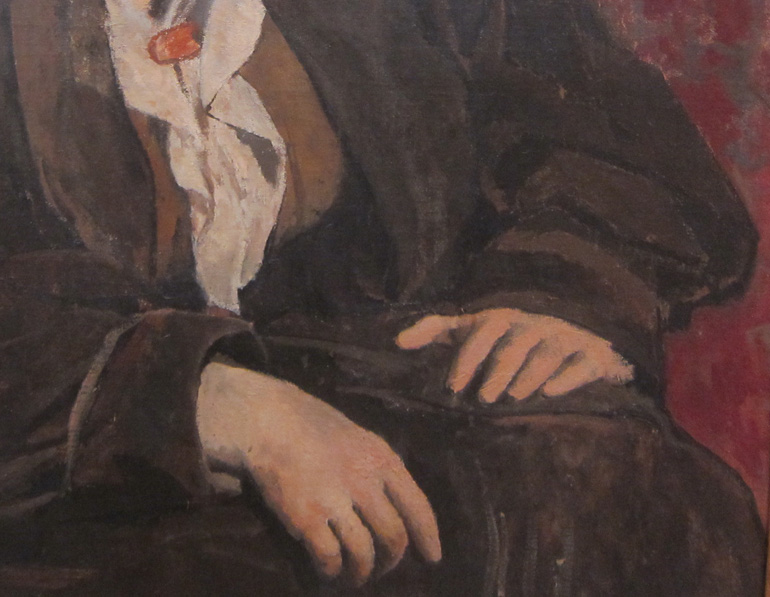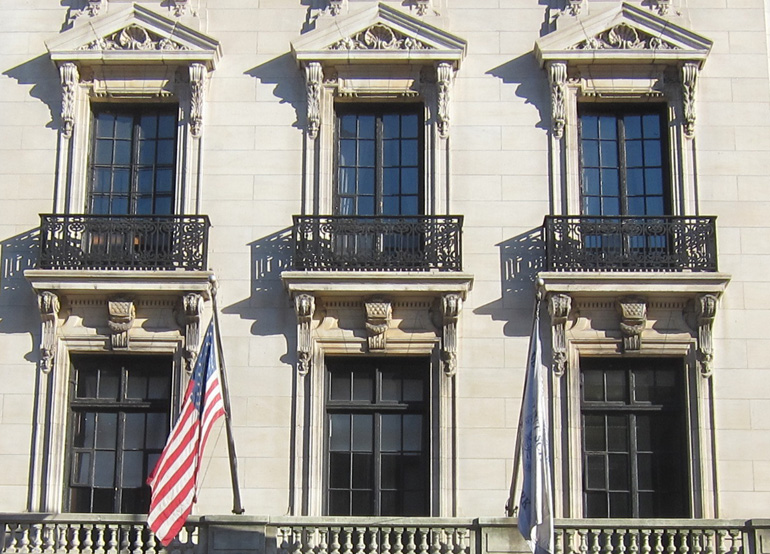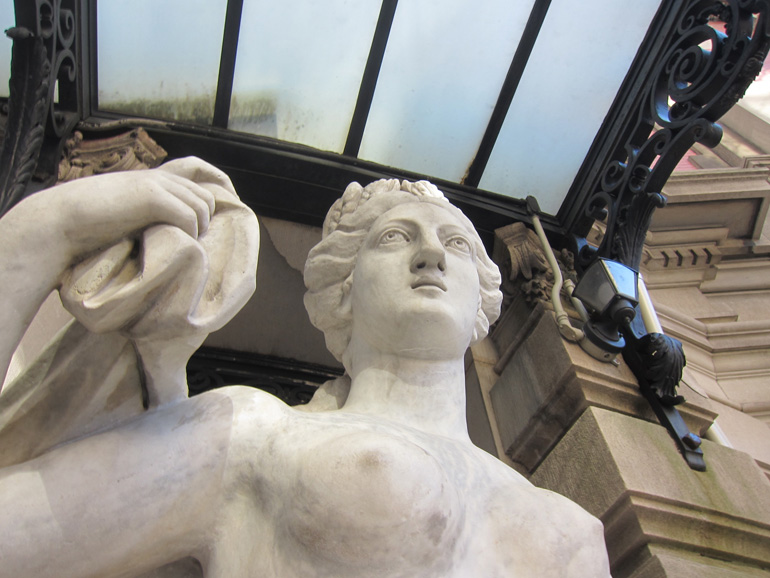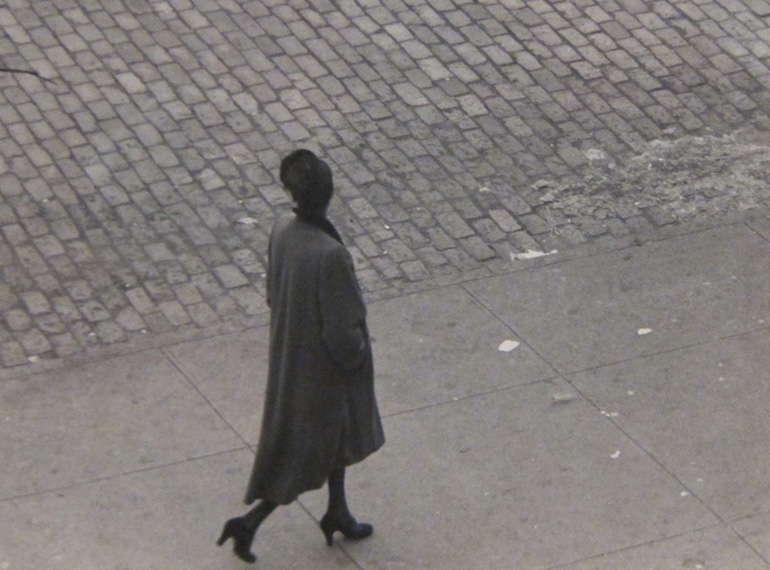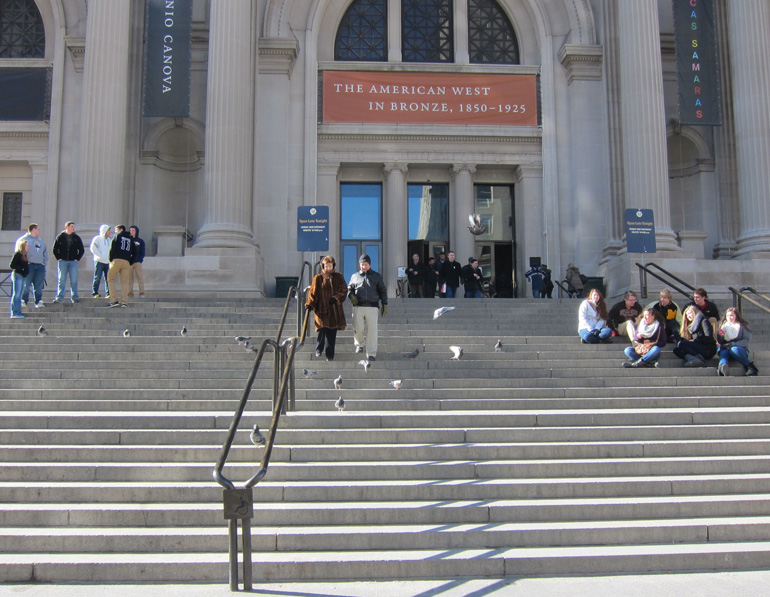Gotham Diary:
The Trouble with Productivity
1 April 2014
Monday, March 31st, 2014
Late yesterday afternoon, I watched Hannah Arendt for the second time. It struck me even more forcefully than it did the first time as an extraordinarily good movie with some extraordinarily regrettable lapses. Almost all of the latter concern the representation of America, either as landscape (mostly faked with obviously German stand-ins) or as society. The problem with the movie’s picture of American society is that nearly every American in the film is a caricature. Whether this reflects an agenda on Margarethe von Trotta’s part or simply a fumble in communication between a Continental director and an Anglophone cast, I can’t say, but every time a braying or strident American interrupts the velvet flow of German, I want to stop my ears.
However: extraordinarily good, that’s the thing to bear in mind. As a movie about a thinking human being, Hannah Arendt is unparalleled. Thinking, of course, cannot be shown on screen — just the face of someone who is thinking. At this, Barbara Sukowa is as convincing as anyone. But she is supported by a superb screenplay, superbly photographed.
Hannah Arendt tells the story of how Arendt came to write Eichmann in Jerusalem, and how her book was received when it was serially published in The New Yorker. A very great deal of the movie is taken up with Ms Sukowa’s Arendt reacting to what she hears, both silently and in speech, and these reactions reveal thought in the same way that a powdering of snow reveals the Invisible Man. Arendt’s first reactions are to Adolf Eichmann himself. She is shocked, surprised. The man is a mediocrity, a nobody. He doesn’t boast or bluster; he just yammers on about swearing oaths and obeying orders. (That the man is physically so unprepossessing — not an accountant but the file clerk to an accountant — is also jarring.) You might think that the author of The Origins of Totalitarianism, which dilates on the relentlessness with which totalitarians destroy the humanity not only of their victims but of themselves as well, would be prepared for the moral cypher that Eichmann became, but she wasn’t. At one point, she calls him a ghost. Isn’t that what her earlier book would have foretold? Only in hindsight, it seems.
When she has considered Eichmann at length, she finds it difficult if not impossible to get any of her Israeli friends to hear her out. They can’t hear her out, because her mockery of Eichmann makes a mockery of the Holocaust. They can’t or won’t follow her into this classic instance, this actual case, of totalitarian annihilation. For them, the only victims are the shot and the gassed. To annihilate the humanity of the functionaries who managed the killing is to dismiss the criminality of the Holocaust itself, an inadmissable conclusion. But that was precisely Arendt’s conclusion, already reached, in theory as it were, in Origins, and now from experience, watching Eichmann. Totalitarianism is radically evil because it annihilates humanity and, with it, all meaningful conception of law. You can punish totalitarians, but you cannot judge them. Morally, they are already dead. That is what makes them banal.
To compare Hitler (or even Eichmann) to Satan is an insult to Satan. Satan is a fallen angel, a rebel against God. No one is more expert at parsing good and bad. Hitler taught us, I’m afraid, that we have outgrown Satan. But Satan is very familiar and we are attached to the very familiar. In the movie, Hannah Arendt has a hard time, understandably, making the case that Satan is passé. It has perhaps required the passage of fifty years for the case to become even presentable.
***
As a young woman, Hannah Arendt was a distinctly apolitical philosophy student, but she was still young when she learned that ignorance of political affairs can be very foolish. She became a political thinker, somebody who thought endlessly about politics — more precisely, about the environmental factors that must be in place for politics to occur — against the grain of her studies. I don’t know when she hit on her most elemental discovery, which is that all you need to understand politics is the ability to think, but she probably did not pick it up from her teacher, Martin Heidegger, who opportunistically/naively went along with the Nazis at a fairly early point. I don’t know how long it took her to see how destructive Plato had been when he advised philosophers to dismiss politics, but in fact she wrote very little between her exile to France (when her conventional academic career came to an end) and the end of the War (by which time she was in New York). She had been trained, as a thinker, to avoid thinking about politics, but over the course of her mature life, she taught herself how (to use one of her favorite phrases) to turn that on its head. While all the ingredients of her discussion were the familiar monuments of Western intellectual history, she rearranged them even more strenuously than Karl Marx did. (She certainly rearranged him.) In my (admittedly besotted) view, this rearrangement amounted to a reinvention.
To the end of later editions of Origins, Arendt appended an essay, “Ideology and Terror.” Initially, the essay was an attempt to classify totalitarianism among the forms of government à la manière de Montesquieu. This project led Arendt to a startling realization: once Plato started daydreaming about philosopher-kings, political philosophy was launched on a course that deliberately ignored politics — in Arendt’s terms, the free action of plural men. (The plurality and the natality of men — unique individuals are born every day, and grow up, some of them, to lead public affairs — is the second most-important idea in Arendt’s armory. There never has been and never will be any such thing as “mankind” — only a god, she says, would know what that was.) Plato, as exasperated by politics as we all are, decided to dispense with it by handing over the government directly to a ruler, and from then on, political philosophy was concerned with the different forms of rule.
In a republic, however, rule, or law, must be preceded by some sort of popular resolution, however you define “popular.” That is what politics is — not rule. No American ought to have any difficulty understanding this; it’s built into the Constitution. We elect legislators to make laws and a president to execute them. And yet — even the Founders didn’t understand politics, which they called “Faction.” Political parties, born less than a century earlier in England, still, in the 1780s, seemed a somewhat adventitious, accidental imperfection in an ever-improving design. I have yet to read Arendt on parties per se, if indeed she ever wrote about them, but I expect that she would have regarded them as imperfect necessities. (I also expect to learn more in this area from On Revolutions, which is in the mail.)
Somewhere in an interview, Arendt told the correspondent that, when it came time to write things down, she was always ready because she knew what she thought and she simply wrote that. Allowing for exaggeration, we must nevertheless admit that this spontaneity shows, in ways that make reading Arendt fascinating and hugely rewarding but also maddening. Arendt is an anti-journalist. She seems to be completely innocent of all the low-grade rhetorical cunning that was drilled into us in high school. Remember the rule about beginning an essay with a funnel (lots of broad statements at the beginning, narrowing down bit by bit until, voilà, the “topic sentence” at the end of the first or second paragraph)? Arendt begins in media res. You plunge into the deep end — there is no shallow — and swim as best you can. Every sentence is clear and reasonable-sounding, but its connection to its neighbors is sometimes invisible: it’s something that you, the reader, have to work out for yourself. This would have consigned the work of a lesser thinker to oblivion.
Not that there is anything heedless or macho about Arendt’s writing. Rather it reminds me of a venerable “Catholic joke.” An old lady is in the middle of praying to the Virgin when she’s interrupted by Jesus Himself. He tries to tell her who He is, and to let her be the first to know about the Second Coming, but she dismisses Him unceremoniously: “Shut up, I’m talking to Your mother.” Substitute you, the reader accustomed to being persuaded, for Jesus, and the urgency of avoiding another outbreak of totalitarianism for the Virgin, and the old lady becomes Hannah Arendt.
That Hannah Arendt was a woman, whose books were written by a woman, seems significant not because the books display any “womanly” characteristics but because she and her work are free of two defects that beset the work of brainy males. The first of these weaknesses is what would be called “playfulness,” if you thought of what goes on between cats and mice as “play.” Although the disciplines underpinning systematic philosophy and multiplayer video games differ widely, I regard them as variant methods of scratching the same itch. The second weakness, which you might expect to cancel out the first, is the urge to conclude. But winning the game quite often requires continuing to play. Arendt never stops, either, but, even at her most thunderingly authoritative, she never offers propositions on a scale that would put her inquiry to rest. She is not trying to win a game. She is trying to make sure that no important questions have been overlooked.
(Decency requires me to mention that Albert Hirschmann, last spring’s crush, was, although a very brainy male, singularly free of the “besetting defects.” There are a few good men out there, to be sure.)
Hannah Arendt’s enemy was not intellectual or virtual, but dreadfully, catastrophically incarnate (even if also dead), and it can be said without stretching the facts that she dedicated her survival of the Holocaust to understanding it. She applied her skills as a crack intellectual analyst to shedding light on the evasive murk of anti-political impulses.
***
Every once in a while, a friend interrupts my rattling on about Hannah Arendt to ask if I’m afraid of a totalitarian outbreak anytime soon. The answer to that is “no.” But what does worry me is a misunderstanding about labor that might make such an outbreak more likely, and Arendt has taught me to phrase it that way. “Misunderstanding about labor” — am I talking about jobs? Yes, but not the ones you think. Marx, by misunderstanding labor — he seems to have regarded it simply as the opposite of idleness or unproductive activity — privileged the one kind of doing that human beings share with other animals: the labor, the ceaseless round, of trying to stay alive. The valorization of productivity for its own sake, as common among capitalists as it ever was for the Stakhanovites, has reduced almost all forms of work to the status of labor: job-holding. People worried about keeping their jobs, in a society that proclaims “grow or die,” are workers only nominally: the manufacture of tables and trust documents (work, in Arendt’s view) becomes a byproduct of the dire need to assure an uninterrupted flow of paychecks — labor. Everybody is working too hard and laboring too much, but the worst of it is that it’s the best and the brightest (and I don’t mean CEOs here — they’re the jokers in the pack) who are wasting their intelligence not on “careers” but on jobs. Leisure, the basis of meaningful political reflection, is lost, because “nobody has the time.” That’s why politics in America has become so polarized. It has been abandoned to the players.
If the graduates of our best schools and the recipients of our highest professional salaries can’t figure out how to organize their lives to their own satisfaction (which, by the wonderful geometry of humanity, correlates over the long run to the general satisfaction), we have a problem, Houston, don’t we? Before Arendt, I’d have said that the problem is that there’s not enough reflection in modern society. Now, thanks to her, I know why that’s the case — and I’m really worried.





